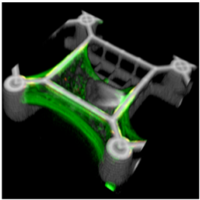Topic 2: Cell Populations on Biofunctional Surfaces
Topic 2 is dedicated to develop third generation biotechnology for the control and manipulation of eukaryotic cells, in particular stem cells, and of bacterial biofilms in artificial environments. Our goal is to rationally design and engineer sophisticated culture devices as an approach to specifically manipulate these multicellular systems at the molecular level. Innovative bioreactors to create artificial organs or to expand and control the differentiation of stem cells will find applications e.g. for drug testing or cell therapy. Furthermore, advanced technical devices and surfaces for controlling biofilm formation and harnessing their unique, complex properties will be a major source of innovation in biotechnology, for example in bioproduction and water purification, as well as in strategies for limiting biofilm formation in clinical settings. These technology developments, we collectively refer to as third-generation biotechnology.
In order to achieve these goals we tackle the following specific questions and aims:
- How do specific properties of artificial surfaces (chemical, biological and physical) influence cell behaviour (e.g. differentiation of stem cells, bacterial adhesion and growth)?
- Do eukaryotic cells and bacterial biofilms share common principles of cell-surface interaction? Alternatively, are there specificities which, for example, could be harnessed to favour species-specific adhesion?
- What are the underlying molecular mechanisms whereby the surface properties influence particular aspects of cell behaviour? Can we exploit this knowledge for innovative approaches to control cells?
The control of the behaviour of eukaryotic cells, for example the fate of stem cells, relies on the integration of complex temporal and spatial combinations of biochemical and biophysical factors. Knowledge of these factors will guide the engineering of artificial biomimetic environments, which recapitulate the desired properties of the natural environment. These technology developments will form the basis for a novel generation of sophisticated 3D cell culture devices, which will find applications for basic research, as well as in biomedicine and biotechnology.
For bacterial biofilms, technology developments are focused on tailored microfluidic reactors for cultivation of multispecies communities under controlled hydrodynamic conditions. These will enable the characterization of biofilm fluid structure interaction and dynamics, using state-of-the-art analytical methods based on spectroscopy, microscopy, sequencing, and metabolic profiling. These engineered fluidic reactors will be used to exploit multi-species microbial consortia for a third generation of biotechnologies, with applications such as biofilm-based production of valuable molecules, or for selective removal of contaminants. Furthermore, our work on the fundamental principles of biofilm-surface interaction will find applications for the rational design of novel materials and surfaces aiming to avoid or control biofilms in clinical settings.
All our activities heavily rely on strong input from the Microengineering & Polymers Hub for the production of the required multiple substrates and sophisticated analytical devices and the microBioprocessing Hub for the development of cell-free, compartmentalised microfluidic bioreactors. In addition, Topic 2 activities rely upon essential technology platforms: the Soft Matter Synthesis Lab (SML), the Structure Analsysis and Modelling platform, the Bioinformatics platform and the OMICS platform.
